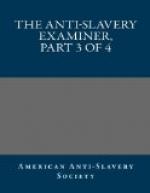“Do you believe it, sir, not six months since, I saw a number of my Christian neighbors packing up provisions, as I supposed for a deer hunt; but as I was about offering myself to the party, I learned that their powder and balls were destined to a very different purpose: it was, in short, the design of the party to bring home a number of runaway slaves, or to shoot them if they should not be able to get possession of them in any other way.
“You will ask, Is not this murder? Call it, sir, by what name you please, such are the facts:—many are shot every year, and that too while the masters say they treat their slaves well.
“But let me turn your attention to another species of cruelty. About a year since I knew a certain slave who had deserted his master, to be caught, and for the first time fastened to the stocks. In those same stocks, from which at midnight I have heard cries of distress, while the master slept, and was dreaming, perhaps, of drinking wine and of discussing the price of cotton. On the next morning he was chained in an immovable posture, and branded in both cheeks with red hot stamps of iron. Such are the tender mercies of men who love wealth, and are determined to obtain it at any price.
“Suffer me to add another to the list of enormities, and I will not offend you with more.
“There was, some time since, brought to trial in this town a planter residing about fifteen miles distant, for whipping his slave to death. You will suppose, of course, that he was punished. No, sir, he was acquitted, although there could be no doubt of the fact. I heard the tale of murder from a man who was acquainted with all the circumstances. ‘I was,’ said he, ’passing along the road near the burying-ground of the plantation, about nine o’clock at night, when I saw several lights gleaming through the woods; and as I approached, in order to see what was doing, I beheld the coroner of Natchez, with a number of men, standing around the body of a young female, which by the torches seemed almost perfectly white. On inquiry I learned that the master had so unmercifully beaten this girl that she died under the operation: and that also he had so severely punished another of his slaves that he was but just alive.’”
We here rest the case for the present, so far as respects the presentation of facts showing the condition of the slaves, and proceed to consider the main objections which are usually employed to weaken such testimony, or wholly to set it aside. But before we enter upon the examination of specific objections, and introductory to them, we remark,—
1. That the system of slavery must be a system of horrible cruelty, follows of necessity, from the fact that two millions seven hundred thousand human beings are held by force, and used as articles of property. Nothing but a heavy yoke, and an iron one, could possibly keep so many necks in the dust. That must be a constant and mighty pressure which holds so still such a vast army; nothing could do it but the daily experience of severities, and the ceaseless dread and certainty of the most terrible inflictions if they should dare to toss in their chains.




